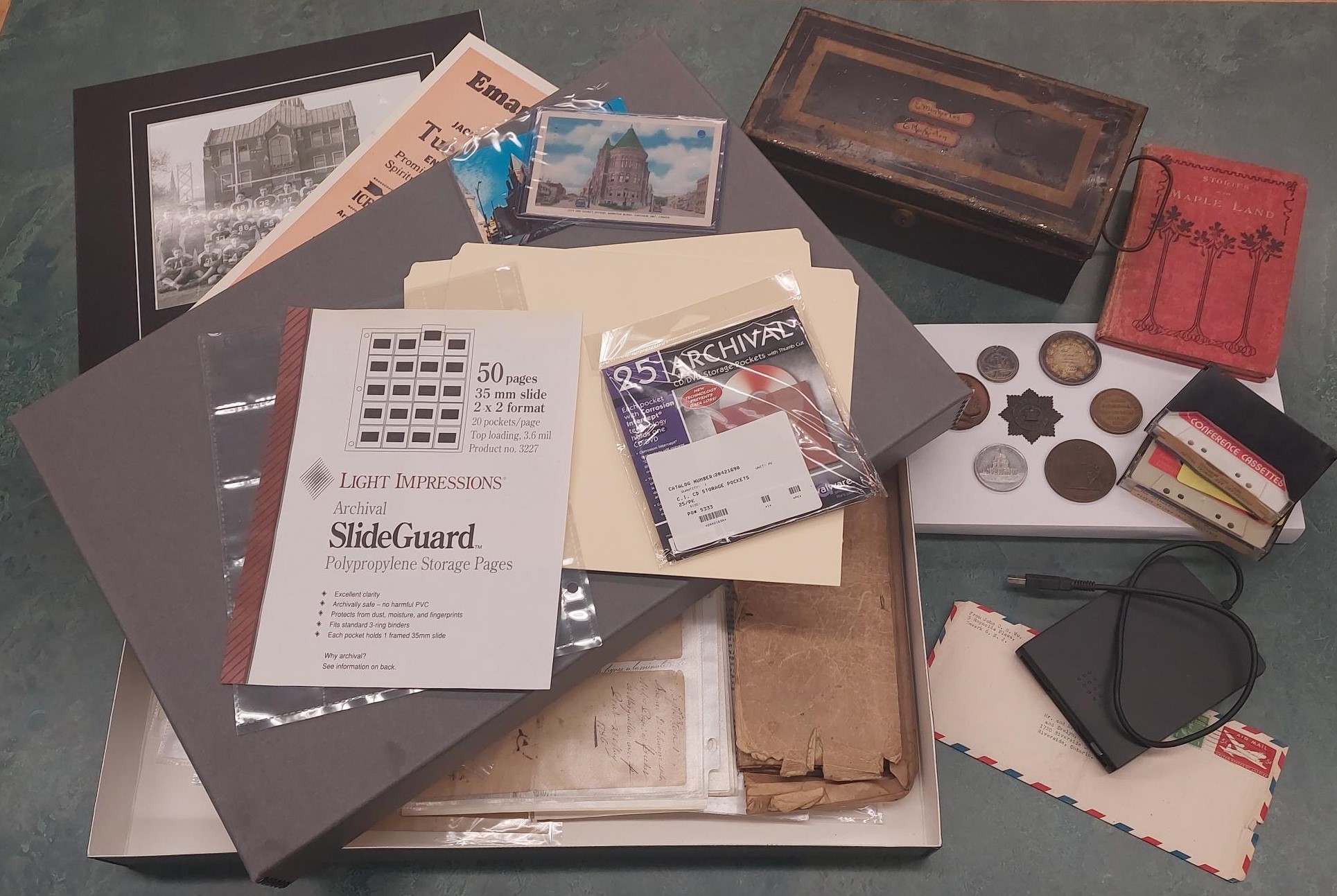
Posted March 27, 2024
Every day, around the world, people engage in the act of archiving. And not just professional archivists, either. Countless fascinating and historically valuable items never go to institutions, but instead stay in the families or private organizations for whom they are most meaningful.
As we go about our daily lives we consciously or unconsciously make decisions about what to dispose of and what to keep. In honour of Archives Awareness Week (April 1-5) 2024, this post shares some basic tips and links to more in-depth resources that can help extend the lifespan of our treasured materials, from a collection of early 20th century sports memorabilia or a box of 1980s children’s toys, to digital family photos and more.
Enemies of Preservation:
Regardless of the type of item, here are the threats you want to avoid:- Direct sunlight, fluorescent light, or really any prolonged exposure to light at all.
- Water – flooding, dampness (and its friend, mould), and fluctuating humidity levels.
- Dust and dirt – including dirty, sticky, or damp hands.
- Heat – fire, obviously, but also fluctuating temperatures.
- Physical damage – from rough handling, acidic storage materials, lamination, or stickers/tape/glue/Post-it notes applied to the materials.
- Pests – mice and a variety of insects.
- Digital or audio-visual obsolescence – leaving you unable to access or play the materials.
For the above reasons, attics, basements, and garages are not great places for archives. (A home office or spare bedroom closet would be great, and a bit cooler than room temperature is preferable.) But the reality is that attics and basements are often the only places with available space. So, if you must use them, try to put some measures in place to minimize the potential harms listed above.
Here are some quick tips and links to in-depth resources for the main types of archival items and artifacts you might be looking to preserve:
Preserving Paper Documents
Store documents flat and unaltered (not folded or rolled up or framed or laminated), remove any rusty paper clips or staples, and separate highly acidic paper (I’m looking at you, newspaper clippings!) from other types. Acid- and lignin-free folders and boxes are ideal (but can be pricey).
Pro tips: Storage and Handling for Books and Artifacts on Paper — NEDCC leaflet
Preserving Photographs
Handle with care (don’t touch the image itself, don’t use pen or marker to write on the back), and store flat, in some kind of protective storage – but not photo albums with self-adhesive pages (the glue will degrade your photos). Acid- and lignin-free photo envelopes, clear polyester sleeves, or archival-quality multi-photo holder pages are all good options.
Pro tips: Care of Photographs — NEDCC leaflet
Preserving Audio-visual Materials
Some formats (like LP-style records) are relatively long-lived. Others (like reel-to-reel, VHS, and cassette tapes) are actively degrading as you read this and may be unusable within a decade. Digitization-for-preservation is often the only solution for long-term preservation, and paying a professional to do the transfer might be a wise investment.
Pro tips: Care and Handling of AV Collections — NEDCC textbook chapter
Preserving Digital Materials
Software and hardware quickly become obsolete, so be prepared to migrate your files to new formats again and again, to ensure you can continue to access them. Over time, individual digital files are also prone to spontaneous corruption. Save back-ups on different storage media, and observe the LOCKSS principle: Lots of Copies Keeps Stuff Safe.
Pro tips: Digital Preservation — NEDCC leaflet
Preserving Other Types of Artifacts
Textiles are especially susceptible to light and pests; metal objects to rust and corrosion. Leather is always difficult to preserve, and wood is relatively easy. Plastics vary widely. Attempts to clean or restore textiles, metals, and leather will usually damage them unless undertaken by a trained conservator.Pro tips: Textiles, Metal, Leather, and Wood Artifacts — The National WWII Museum blog post
Preserving historical items over the long term is no easy task. That’s why publicly accessible archives like Leddy Library’s Archives & Special Collections have secure, temperature- and humidity-controlled, darkened spaces, use acid- and lignin-free storage supplies, and have elaborate systems for digital preservation. We take seriously our responsibility to steward these resources for the benefit of the wider community.
But even without professional premises, anyone can take steps to preserve their personal archives and artifacts. Remember the enemies of preservation (direct light; water; fire; pests; mould; fluctuating temperature and humidity; acidic storage materials) and try to mitigate those threats.
That said, don’t let “perfect” be the enemy of “good.” If you can’t address all the possible threats to preservation, focus on addressing the ones you can. It is the natural way of things for objects to decay: for both ordinary citizens and professional archivists and curators alike, all we can do is try our best, with the resources available, to preserve these treasured items until they pass to their next set of caretakers.
Bonus Tips
Looking for professional-quality archival supplies? Many products available in office supply or craft stores labelled “archival” do not actually meet the requirements for proper preservation. If you want the real deal, try these vendors used by actual archives and museums: Carr McLean, Brodart, and Gaylord Archival. [*Not a paid endorsement; we really use their supplies.]Wondering how to get started with no budget or resources? Check out the Northeast Document Conservation Center’s video No Budget Preservation Tips, and think about which items in your collection need the most care, the most quickly. Start there, and do what you can.
Dr. Sarah Glassford has been an archivist in the University of Windsor’s Leddy Library Archives & Special Collections unit since 2019. She is currently also the Special Collections librarian and the liaison librarian for History. When time permits, she researches and writes in the field of modern Canadian History.

Connect with your library